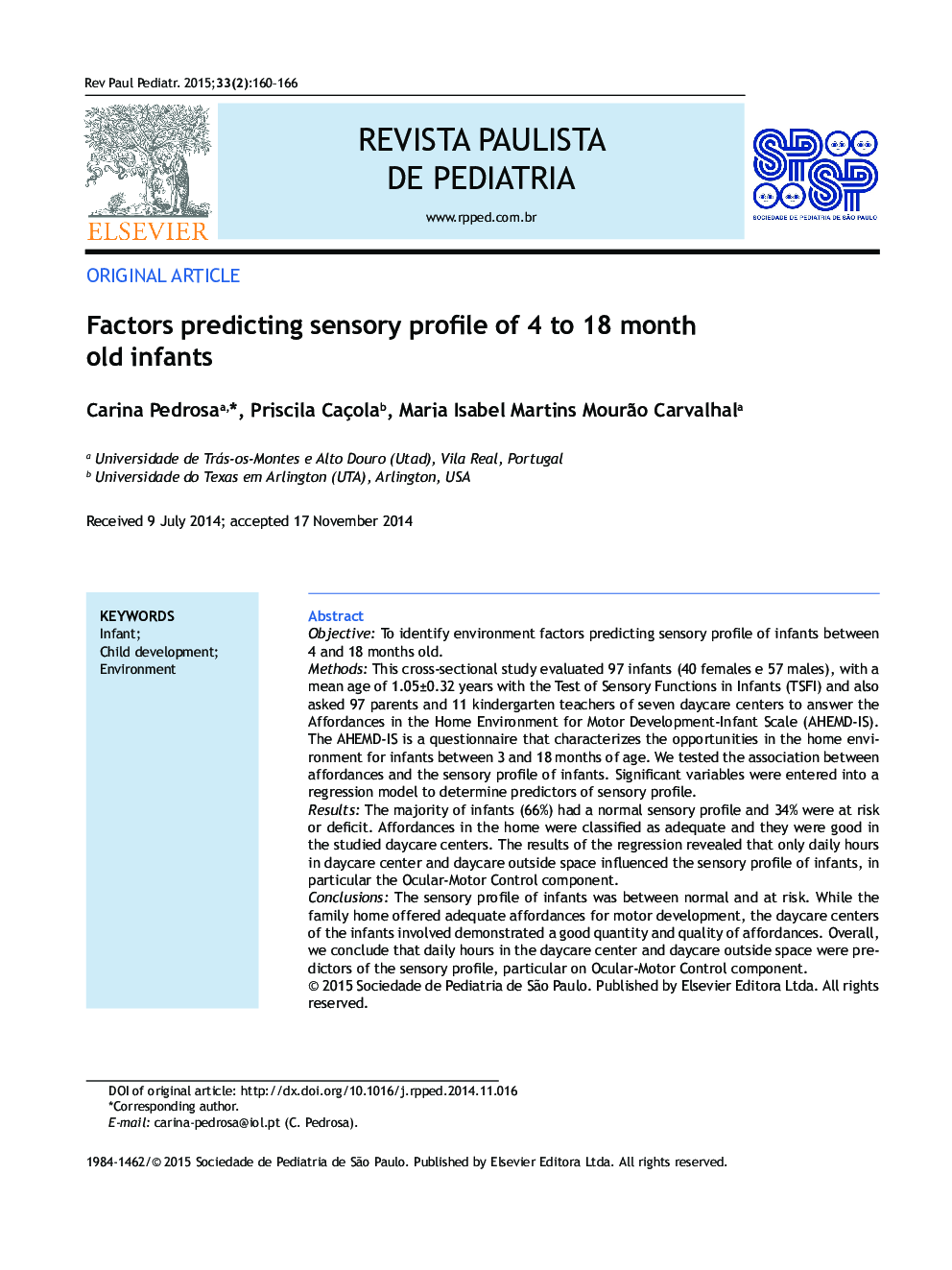| کد مقاله | کد نشریه | سال انتشار | مقاله انگلیسی | نسخه تمام متن |
|---|---|---|---|---|
| 4176258 | 1276241 | 2015 | 7 صفحه PDF | دانلود رایگان |
ObjectiveTo identify environment factors predicting sensory profile of infants between 4 and 18 months old.MethodsThis cross-sectional study evaluated 97 infants (40 females e 57 males), with a mean age of 1.05±0.32 years with the Test of Sensory Functions in Infants (TSFI) and also asked 97 parents and 11 kindergarten teachers of seven daycare centers to answer the Affordances in the Home Environment for Motor Development-Infant Scale (AHEMD-IS). The AHEMD-IS is a questionnaire that characterizes the opportunities in the home environment for infants between 3 and 18 months of age. We tested the association between affordances and the sensory profile of infants. Significant variables were entered into a regression model to determine predictors of sensory profile.ResultsThe majority of infants (66%) had a normal sensory profile and 34% were at risk or deficit. Affordances in the home were classified as adequate and they were good in the studied daycare centers. The results of the regression revealed that only daily hours in daycare center and daycare outside space influenced the sensory profile of infants, in particular the Ocular-Motor Control component.ConclusionsThe sensory profile of infants was between normal and at risk. While the family home offered adequate affordances for motor development, the daycare centers of the infants involved demonstrated a good quantity and quality of affordances. Overall, we conclude that daily hours in the daycare center and daycare outside space were predictors of the sensory profile, particular on Ocular-Motor Control component.
ResumoObjetivoIdentificar os fatores ambientais preditores do perfil sensorial de lactentes dos quatro aos 18 meses de idade.MétodosEstudo transversal com 97 lactentes (40 do sexo feminino e 57 do masculino), comida de média de 1,05±0,32, aos quais foi aplicado o Test of Sensory Functions in Infants. Responderam ao questionário Affordances in the Home Environment for Motor Development-Infant Scale 97 pais e 11 educadoras de sete creches, de forma a caracterizar o contexto familiar e de creche, e relacionou-se ao perfil sensorial dos bebês. O AHEMD-IS é um questionário que caracteriza as oportunidades no ambiente para crianças entre três e 18 meses de idade. As variáveis que apresentaram uma associação significante foram incluídas no modelo de regressão linear para determinar os fatores preditores do perfil sensorial.ResultadosA maioria dos bebês (66%) apresentou um perfil sensorial normal e 34% deles encontram-se em risco ou em déficit (com problemas sensoriais). As oportunidades de estimulação na habitação foram classificadas como suficientes e nas creches foram avaliadas como boas. Os resultados da regressão revelaram que apenas os fatores “horas diárias na creche” e “espaço exterior de creche” influenciaram o perfil sensorial dos bebês, notadamente o controle oculomotor.ConclusõesO perfil sensorial dos bebês situou-se entre o normal e em risco. O contexto familiar oferece oportunidades de estimulação suficientes e as creches demonstraram ter boas oportunidades. As horas diárias em creche e o espaço exterior em creche foram os preditores do perfil sensorial no controle oculomotor.
Journal: Revista Paulista de Pediatria (English Edition) - Volume 33, Issue 2, June 2015, Pages 160–166
